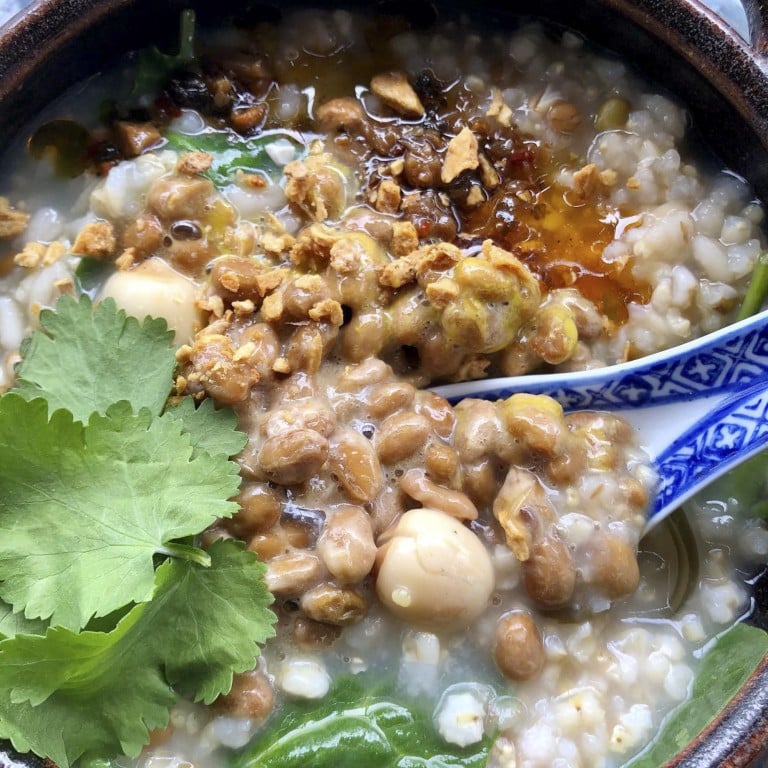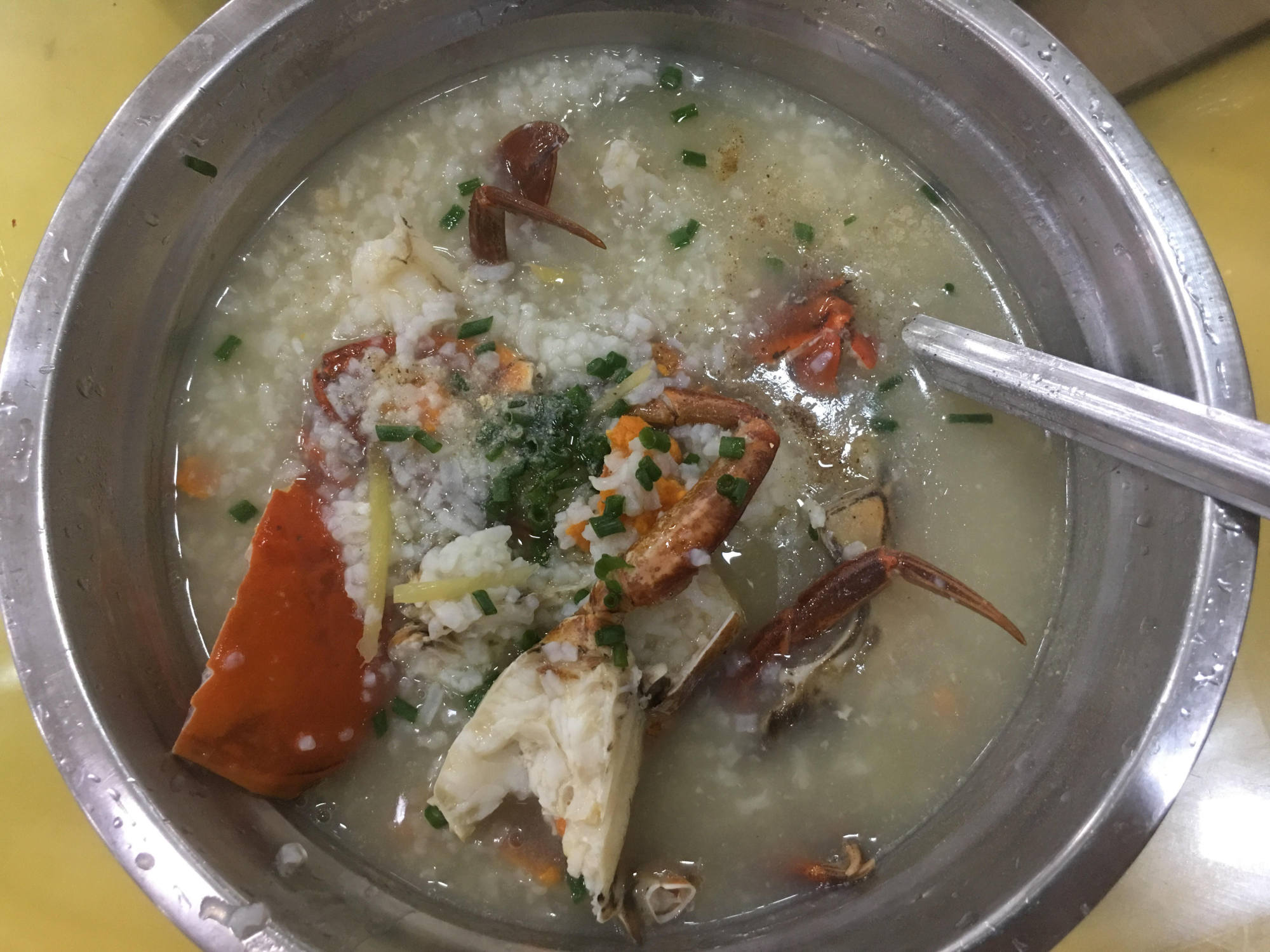
Congee purists vs maximalists: why the humble rice porridge polarises diners. Plus: should you eat it at Lunar New Year?
- Congee, the rice porridge that is loved across Asia, has an almost unlimited variety of toppings, and is often eaten as a restorative
- The jury is still out about when to eat congee at Lunar New Year, with its associations with poverty, although in Cantonese its name ‘jook’ sounds like ‘plenty’
There is a particularly punny piece of graffiti on the streets of Hong Kong.
It reads, “[Jook]er. Am I a [jook] to you?” – the “jook”, which sounds similar to “joke” and means “congee”, is written using the traditional Chinese character – and the clash of language and meaning is so absurd it made me laugh for a good minute or two.
But let’s be real. Congee is no joke. Like so many other ubiquitous foods out there, however, it is often underappreciated; thought about only, perhaps, when either of two situations arise – you are out for breakfast, or you’re ill.
Long live the humble congee shop, with its grease-stained glass cabinets warming crunchy logs of fried dough (yau zha gwai, or youtiao) to be dipped unceremoniously into the velvety depths of a perfect bowl of jook, with its simple but restorative powers.
Congee connoisseurs often use the word “cottony” in reference to that soft, fluffy sensation of rice that has been cooked into submission in water or broth over a long period. (A recent experiment by Cook’s Illustrated magazine found that simmering for at least 45 minutes allowed the rice to release enough starch to create a luscious and viscous congee.)
It’s the pinnacle of gentle textures in the Chinese culinary canon, a marker of excellence.
A great congee is hearty but not cloying, which a stodgy oatmeal porridge can sometimes be, and provides more structure than a bowl of broth. It is no wonder that it’s often prescribed as a restorative food in Asian homes.
But not all congees are made the same.
The type referred to above is fully in the Cantonese style, a thicker porridge with glossy depth, its semi-translucency clinging to some of the more common ingredients you might extract from it – glassy century eggs, say, or tasty pork balls with their craggy exteriors.
When it comes to comfort food, nothing beats Chinese congee
I am quite partial to one of the cheaper options: minced marinated beef bolstered with broken nubs of fried rice noodles – one theory is that vendors did this not only to give the meatballs a lighter, fluffier texture, but also to stretch out the portions of beef.
It fits with the philosophy of congee, which is to turn meagre portions of rice into something entirely different yet still highly appreciated.
However, this association with poverty and famine – of having to be creative to make the most of what little one has – means that having congee during the first days of the Lunar New Year is seen as deeply inauspicious, even ominous. It is believed that doing so would foreshadow a year of financial hardship.
Fortunately, you don’t have to abstain for long. In the Guangdong region of southern China, congee is welcome, even celebrated, on the seventh day of the Lunar New Year (January 28 in 2023), which is known as Human Day. That is because in Cantonese, the word for congee (the aforementioned “jook”) is a homonym for “plentiful”.
It is ironic given that congee – which in China can be traced as far back as the Zhou dynasty, circa 1,000BC – was previously linked to fasting rituals.
Linguists also point out that the word “congee” has unexpected roots in the Tamil “kanji”, which itself derives from the Sanskrit “kanjika”, referring to a rice gruel given to invalids. The starchy water also had an alternative use during the days of the Raj – the British in India used it to stiffen their cotton shirt fronts (“congied” became a word for this process).
Wagyu, pork belly, cured meats: clay pot rice made luxe by these top chefs
Thankfully, congee today is less often dismissed and frequently looked upon more with reverence.
Those in the know recognise that the stark presentation of the congee at The Chairman, a Michelin-starred Chinese restaurant in Hong Kong, belies its incredibly laborious cooking process; the silky porridge is the result of a vigorous continuous boil that breaks up the rice grains until they are almost imperceptible to the palate.
Served with a sweetly oceanic piece of tender slipper lobster, it is a masterclass in restraint and clarity of flavour – the fragrant rice in harmony with the salinity of the shellfish.

There are other impressive iterations, too. At a recent collaborative dinner between tofu specialist Mora and Ningbo cuisine restaurant Yong Fu, I savoured a truly spectacular congee, slow-simmered with fish bones and plenty of ginger; the porridge was loose, almost watery, with the tiniest grains of tender rice still intact.
It was luxurious in its own way, the trinity of spicy root, umami-loaded fish broth and nutty rice just as impactful as a classic French consommé.
A new dish at modern Korean fine-dining restaurant Mosu Hong Kong features a golden rice porridge that is made using Jinhua ham-rich broth and served with a tranche of tender rockfish.
Then there are the modernist versions that throw subtlety out the window – we’re talking “fully loaded” congees that have sprung up over social media in recent years, the pristine pale traditional porridge all but hidden under a blanket of high-octane condiments and toppings.
Spoonfuls of zhacai (pickled mustard greens) join splashes of sambal and chilli crisp, even sticky mounds of natto, or Japanese fermented soybeans.
“I’m definitely maximalist when it comes to congee,” says Jenny Lau, a London-based communications specialist and the founder of Chinese food stories platform Celestial Peach.
She is also the mastermind behind CongeeCon, an annual event where participants get to chat about food and Asian culture. It started three years ago as a potluck gathering, where congee would be served as a base and each guest was encouraged to bring their own toppings.
“Maybe I was one of the first people in London, in the UK especially, who was kind of starting this ‘congee revival’,” Lau says with a self-deprecating laugh. She suggests that the evolution of CongeeCon was tied to the growing conversations around identity and the effects of anti-Asian racism.
“I just saw congee as the perfect metaphor,” she says, emphasising that the “Con” in CongeeCon can also represent concepts such as connection, conversation and contemplation.

And so congee has become a conduit for some pretty serious topics, even when we’re talking about what Lau likes to add to her bowl.
“You pick what you want and you dress it how you want. And I think there’s something very non-dogmatic about that,” she says. “You can have it your way. You often encounter people who are very ‘gatekeepery’ about ‘our’ culture. You know, ‘That’s not how we serve our congee’. Whose [culture] is it anyway?” she says.
The creative melding of cultures via congee can be seen and tasted at Yangban Society, a Korean-American deli and market in Los Angeles’ Arts District, where chefs Katianna and John Hong create left-field contributions to the Asian dining repertoire with the likes of their congee pot pie.
Crafted with the same thrifty mindset as that of their forebears, the dish came about as a way to use up leftovers at the restaurant.

Yangban’s congee is made with leftover steamed golden millet rice that is then further cooked down with roasted chicken stock, toasted sesame oil, white pepper, ginger, shallot and garlic; it’s placed in a bowl and topped with a round of biscuit crust that is upcycled from the offcuts of their popular biscuit and kare gravy dish.
The congee pot pie was such a hit that the Hongs introduced a second version with northern Californian red abalone, inspired by Korean jeonbokjuk.
With its infinite possibilities and freedom of flavour expression, it would seem the joke might be on those who don’t like congee.

